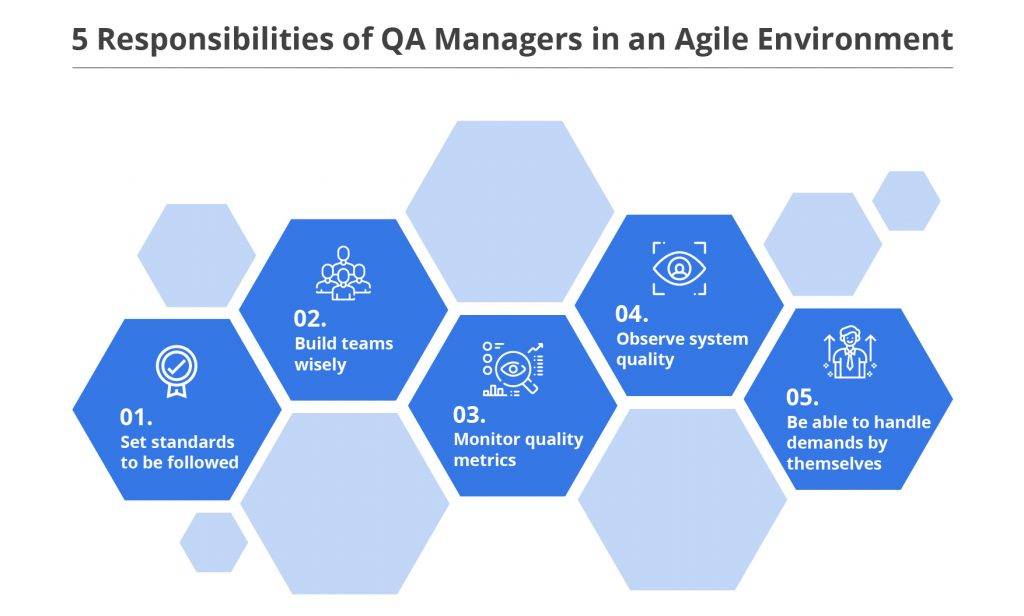Quality Assurance (QA) is different from software development. A Quality Assurance manager needs to have a certain skillset, while being abreast of the latest methodologies, technologies, and trends, in order to be successful in their profession.
Keeping the above in mind, we present to you a list of the top 5 responsibilities of a QA manager, especially tailored to an agile environment.

1. Set standards to be followed
A good QA manager is not controlling; he or she gives their agile team members some responsibility and independence to manage the work by themselves. However, this does not mean that there should be no set standards in place, for the entire team to follow.
The organization as a whole is expected to work as a coherent unit. It should have a few pre-defined standards like:
- Which Software Testing tools to use, and how to use them
- Which Testing Methodologies to apply
- How to deploy effective defect management, e.g. defining defect statuses
- Strategies to recognize the state of a build, and working accordingly.
A QA manager works with the project managers to decide upon the standards that are to be utilized. This ensures that all team members are following similar techniques and being trained according to the same sets of rules. The managers then monitor progress and quality during the development process. These guidelines are used by the R&D team to incorporate QA processes within their development teams.
2. Build teams wisely
All development teams work according to their own area of expertise. For instance, one team deals with the user interface and others concentrate on back-end services. Various areas of development require specialized knowledge like automated and manual testing. Test automation is different as it depends on the user interface, cascading style sheets implementation or REST API.
A QA manager builds the teams carefully, comprising of team members with different skillsets, such as a QA architect, UI testers, functional testers, automation testers, and performance testers. In addition to this, they define responsibilities and roles of team members, and define how to go about tasks. They have to guarantee that the development testers are appropriately equipped to test their team’s specific development work.
3. Monitor quality metrics
A QA manager has to take a macroscopic view of quality by observing the trends in metrics across all teams. This provides a complete view of the quality code of the organization and in recognizing teams that may not be working up to the mark.
There are many reasons why the teams might not be performing according to expectations. They may not be following the defined testing techniques, which could possibly heighten the number of defects. If the QA manager has the right metrics in place, she can easily get to the root of the issue, carefully drill down into the team’s work practices, and bring them up to par.
4. Observe system quality
It’s the QA architect’s choice whether to carry out cross-functional testing to guarantee that everything performs well together. They test the connection between modules in various configurations and environments to guarantee that the system is functioning properly, without any performance, security, or integration issues.
A QA manager’s main responsibility is to reflect on the overall quality of their system. When they look at issues from a system level, they can think of themselves as a bridge between the development, testing, and QA teams.
5. Be able to handle demands by themselves
QA managers should be able to handle demands and arrange resources by themselves, rather than relying on external help such as more QA resources or tools or money. Simply put, they should be able to re-organize existing resources to meet the demands. As an agile unit, ideally all team members should have the competence to run various tests, as all members of the team have multiple skills and anyone can rise to the occasion.
In certain situations, the QA manager may move testers between teams to address requirements for additional testing. This method is called “swarming.”
If you are a QA manager who is seeking ways to thrive in an agile environment, be sure to keep the above points in mind–and watch yourself succeed!
In an agile environment, adaptability and flexibility are key attributes for QA managers. They should continuously evaluate team dynamics and project requirements to ensure optimal resource allocation. Moreover, fostering a culture of collaboration and knowledge sharing among team members can empower individuals to take on diverse testing tasks as needed. By embracing these principles and approaches, QA managers can effectively navigate the complexities of agile development and drive success for their teams and projects.


























